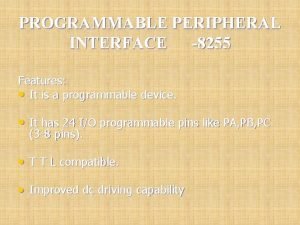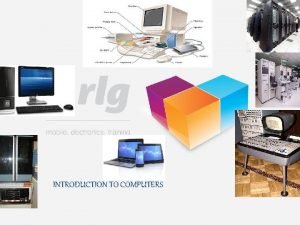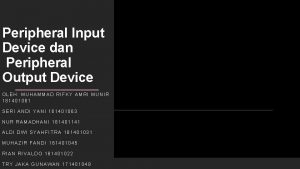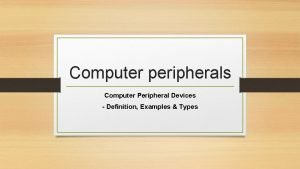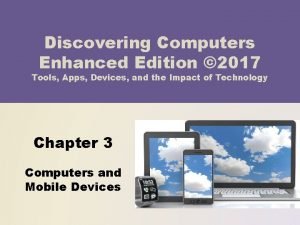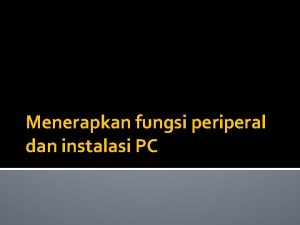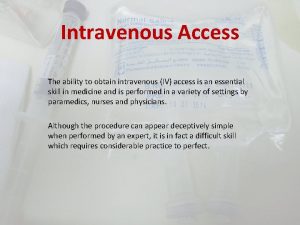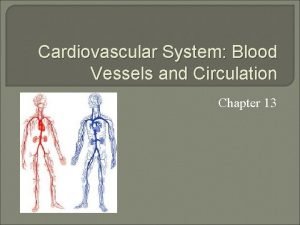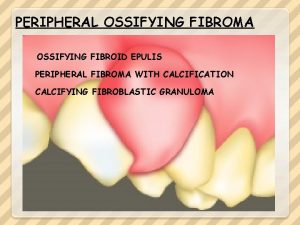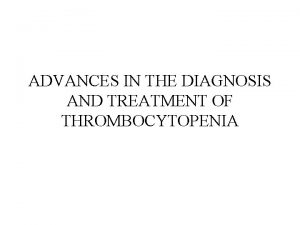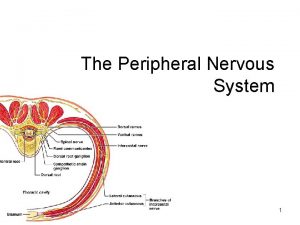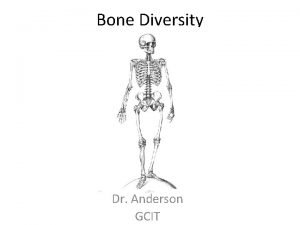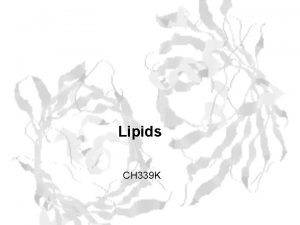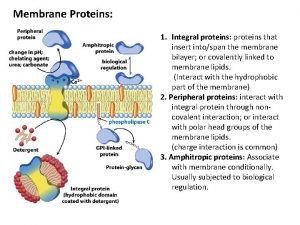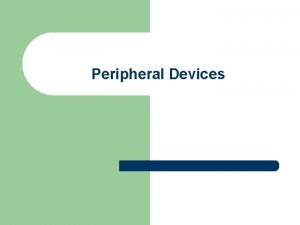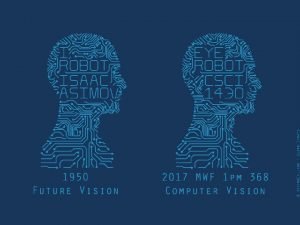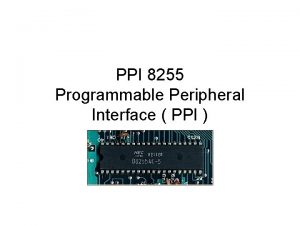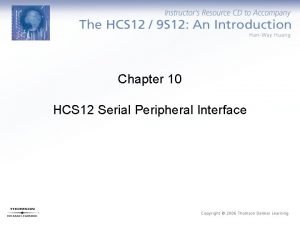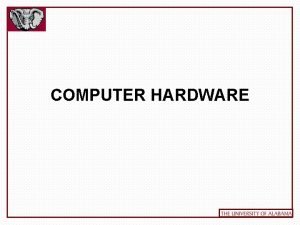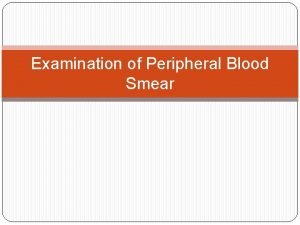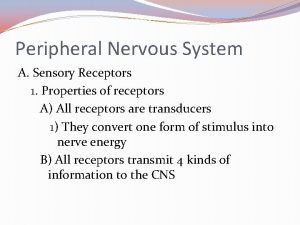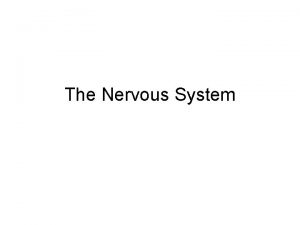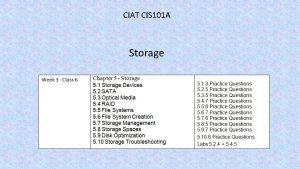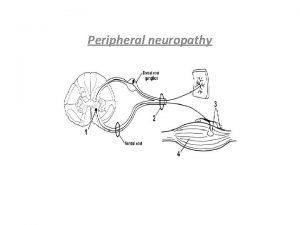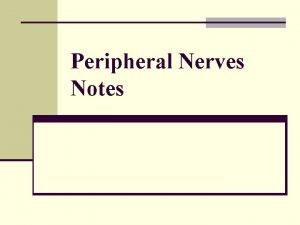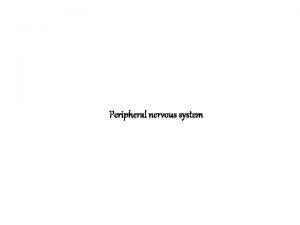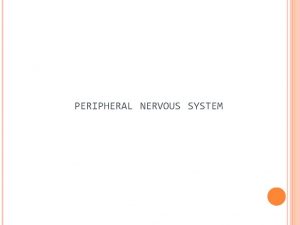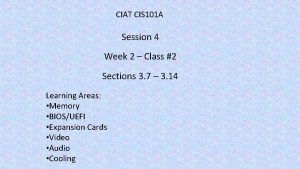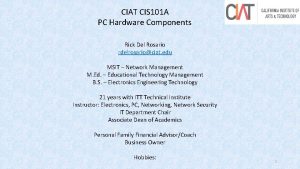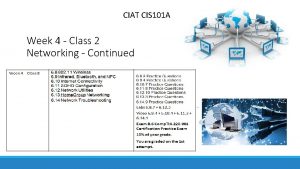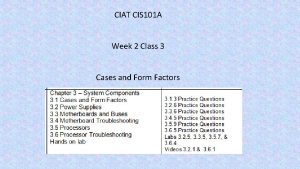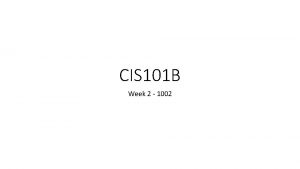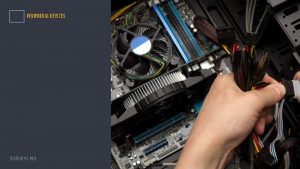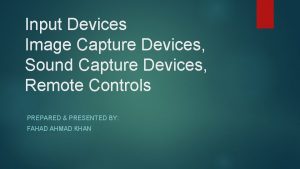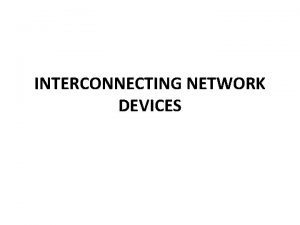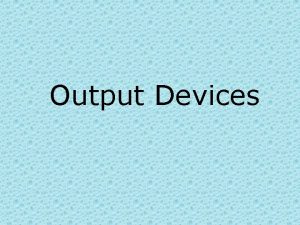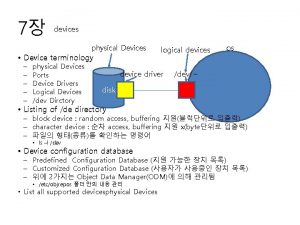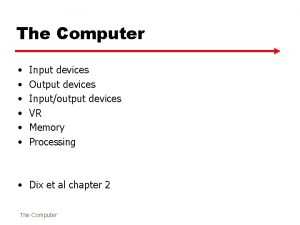CIAT CIS 101 A Peripheral Devices CIAT CIS






















































- Slides: 54

CIAT CIS 101 A Peripheral Devices

CIAT CIS 101 A 4. 1 Peripheral Devices: A peripheral device is any external component that either sends information to or retrieves information from a computer. There are three categories of peripheral devices: 1 – Input Devices 2 – Output Devices 3 – Input & Output (I/O Devices

4. 1 Peripheral Devices: CIAT CIS 101 A The following table describes some of the most common peripheral devices:



CIAT CIS 101 A 4. 2. 2 USB Facts: The Universal Serial Bus (USB) is the most commonly used connection interface. Almost every device (e. g. , laptops, smartphones, tablets, desktop computers) uses USB in some capacity. USB: o Uses serial communication (bits are sent sequentially) o Supports plug and play and hot plugging (adding and removing devices without rebooting) o Allows up to 127 devices to be connected to a single bus, directly to the host or via hubs (hubs are limited to five tiers) o Shares the bandwidth among all devices connected to a single bus o Provides 5 V of power through the cable Note: You may need to add separate power for certain devices extended on the USB bus.

CIAT CIS 101 A 4. 2. 2 USB Facts: USB has several versions, all of which are backwards compatible. The following table describes the specifications of each version: Data transfer rates are limited by the slowest USB version being used. For example, a USB 2. 0 device connected to a USB 3. 0 port will run at USB 2. 0 speeds.

CIAT CIS 101 A 4. 2. 2 USB Facts: USB uses several connector types for various peripheral devices. The following table describes the most common USB connector types: Connector Type A Description A rectangular connector that generally plugs directly into the computer or a hub. Almost all USB cables have one Type-A connector on one of the ends.

CIAT CIS 101 A 4. 2. 2 USB Facts: USB uses several connector types for various peripheral devices. The following table describes the most common USB connector types: Connector Type B Description A square connector with two beveled corners. Type-B connectors are mostly used with printers or external disk drives. Some networking devices, such as hubs and modems, also use this connector. Note: Most USB cables that use this connector have a Type-A connector on one end that plugs into the computer.

CIAT CIS 101 A 4. 2. 2 USB Facts: USB uses several connector types for various peripheral devices. The following table describes the most common USB connector types: Connector mini. USB Description This connector is used by portable electronic devices, such as digital cameras and some portable storage devices.

CIAT CIS 101 A 4. 2. 2 USB Facts: USB uses several connector types for various peripheral devices. The following table describes the most common USB connector types: Connector micro. USB Description micro. USB connectors are designed for smartphones and tablet devices. micro. USB connectors are approximately half the thickness of mini. USB connectors, making them more appropriate for smaller devices.

CIAT CIS 101 A 4. 2. 2 USB Facts: USB 3. 0 introduced several new connector types. The following table describes the connectors used by USB 3. 0: Connector Type-A Description The blue tab indicates that the connector is a USB 3. 0 Type-A connector and capable of USB 3. 0 speeds. USB 3. 0 Type-A connectors are backwards compatible with all previous USB versions. Note: USB 3. 0 operates at over a gigabit data transfer rate.

CIAT CIS 101 A 4. 2. 2 USB Facts: USB 3. 0 introduced several new connector types. The following table describes the connectors used by USB 3. 0: Connector Type-B Description The USB 3. 0 Type-B connector is larger in size and designed to carry both data and power. Due to their increased size, USB 3. 0 Type-B connectors cannot be plugged into older USB Type-B ports. However, USB 3. 0 peripherals that use this port are able to accept older USB Type-B connectors.

CIAT CIS 101 A 4. 2. 2 USB Facts: USB 3. 0 introduced several new connector types. The following table describes the connectors used by USB 3. 0: Connector Micro-B Description The USB 3. 0 Micro-B connector is used by portable devices, such as compact external storage devices, digital cameras, or smartphones.

CIAT CIS 101 A Comparison

CIAT CIS 101 A 4. 2. 2 USB Facts: USB 3. 0 introduced several new connector types: USB devices are connected to computers in one of two ways: 1 - Directly to a USB port located on the motherboard or on the front panel of a case 2 - To an external USB hub that is connected to the computer Note: USB hubs can be chained together to provide even more USB ports. (up to 127 devices)

CIAT CIS 101 A 4. 2. 2 USB Facts: USB devices can be classified according to how they receive power: Type Self-powered Description Devices that rely on their own power supply (i. e. , they are plugged into an AC outlet) are selfpowered devices (sometimes called active devices). USB 2. 0 devices that draw more than 500 m. A of power are required to be self-powered; USB 3. 0 devices that draw more than 900 m. A of power are required to be self-powered. Bus-powered USB cables have wires to carry both power and data. Bus-powered (sometimes called passive) devices get their power via the USB cable. Bus-powered devices are classified as low-powered or high-powered devices, depending on the amount of power they draw from the USB bus. o Low powered devices use 100 m. A or less o High-powered devices use between 100 and 500 m. A (up to 900 m. A for USB 3. 0) Like USB devices, USB hubs can be bus-powered or self-powered. You cannot connect highpowered devices to a bus-powered hub (you can only connect low-powered or self-powered devices to a bus-powered hub). Therefore, self-powered hubs that provide 500 m. A per port are recommended to ensure an adequate power supply to all bus-powered devices that you may wish to connect to the hub. Note: To install a USB device, you typically install the software driver before attaching the device. When you plug in the device, it will be automatically detected and configured.

CIAT CIS 101 A 4. 3. 2 IEEE 1394 (Firewire) The IEEE 1394 standard is a set of specifications for a high-performance serial bus. Companies that develop IEEE 1394 devices and controllers refer to their technology using a specific trademark. o Fire. Wire (Apple) o i. LINK (Sony) o Lynx (Texas Instruments) Note: Fire. Wire is the most commonly used name for IEEE 1394 and is typically used when referring to non-Apple technology. (Firewire operates at 400 or 800 Mbps, USB at 1. 2 Gbps is now faster than Firewire) Fire. Wire: o Uses a serial bus using twisted-pair wiring for data transport. o Supports up to 63 devices on one IEEE 1394 bus. o Capable of isochronous data transmissions, which provides a constant, uninterrupted bandwidth. o Supports plug and play and hot plugging (devices can be added and removed without rebooting). o Provides up to 60 W of power via a 12 V wire. o Supports peer-to-peer transfers (e. g. , data can be transmitted between a digital video camera and a recording device without going through a computer).

CIAT CIS 101 A 4. 3. 2 IEEE 1394 (Firewire) The following table describes the details of common IEEE 1394 standards:

CIAT CIS 101 A 4. 3. 2 IEEE 1394 (Firewire) You should know the following facts about IEEE 1394: o An IEEE 1394 bus does not necessarily include a PC. In other words, various types of devices can potentially act as the root host. The devices on the bus decide the root host each time a device is added or removed from the bus. o The maximum number of hops (other devices) between any two devices is 16. o You cannot connect IEEE 1394 devices to form a loop. o IEEE 1394 devices can be bus powered or self-powered. o IEEE 1394 cables with four wires are not self-powered; IEEE 1394 cables with six or nine wires are self-powered.

CIAT CIS 101 A 4. 3. 2 IEEE 1394 (Firewire) The following table describes the common IEEE 1394 connectors: Connector 6 -pin connector Description The 6 -pin connector is used with Fire. Wire 400 devices. 6 -pin Fire. Wire connectors provide power via a 12 V wire.

CIAT CIS 101 A 4. 3. 2 IEEE 1394 (Firewire) The following table describes the common IEEE 1394 connectors: Connector 4 -pin connector Description The 4 -pin connector is used with Fire. Wire 400 devices and does not provide any power. Devices that use this connection must be self-powered.

CIAT CIS 101 A 4. 3. 2 IEEE 1394 (Firewire) The following table describes the common IEEE 1394 connectors: Connector 9 -pin connector Description The Fire. Wire 9 -pin connector is used with Fire. Wire 800 devices. This connector is most commonly found on Apple computers, such as the Mac. Book Pro.

CIAT CIS 101 A 4. 4 Display Devices: Display devices use a variety of technologies to produce visual information. Because each technology has unique benefits and drawbacks, it is important to understand their differences. The following table describes the most common types of display devices and the technology they use: Display Type LCD are Description LCDs (liquid-crystal displays) use liquid crystal technology to display visual information. LCDs are the most common type of display device and range in size from less than an inch to over 10 feet. Modern LCDs use LEDs (light-emitting diodes) to backlight the screen. o Edge-Lit White LED (EL-WLED or WLED) displays use white LEDs along one edge (usually the top) of the LCD and a light diffuser to backlight the screen. EL-WLED LCDs are the least expensive, thinnest, and most widely used type of LCD. o Full-array WLED displays have an array of white LEDs behind the screen. Full-array WLED LCDs able to dim specific regions of the screen, resulting in a much higher contrast ratio than LCDs that use EL-WLED technology. o RGB-LED displays have an array of special LEDs that are able to emit red, green, and blue light, resulting in superior color accuracy. RGB-LED displays are the most expensive type of backlighting technology. Note: Older LCD monitors, and some LCD HDTVs, use cold cathode fluorescent lamps (CCFLs) for backlighting. CCFLs are able to produce better colors than EL-WLED and full-array WLED technologies, but consume a lot more energy and require an internal inverter.

CIAT CIS 101 A 4. 4 Display Devices: (LCD) LCDs use one of the following panel technologies: Display Type TN (twisted nematic) panels Description o TN (twisted nematic) panels are the most common technology used by LCDs. TN panels have very good response times (1– 5 ms) and refresh rates (60– 144 Hz), so are great for PC gaming. a. TN panels have imperfect color reproduction due to the fact that only 6 -bits per color can be displayed. They mimic true 24 -bit color using dithering and other techniques. b. TN panels have poor viewing angles and contrast ratios. o IPS (In-plane switching) panels have the best color reproduction quality and viewing angles among LCDs, making them well suited for graphic artists, designers, and photographers. a. IPS panels have relatively slow response times (5– 16 ms) and refresh rates (60 Hz) and have a slight purple tint in blacks when viewed from a wide angle. b. High-end IPS LCDs are very expensive (over $1000). Note: Because of how they draw frames, LCDs suffer from motion blur (also called ghosting) when fast movements occur on the display. While motion blur can be reduced with higher refresh rates and lower response times, it can’t be eliminated entirely.

CIAT CIS 101 A

CIAT CIS 101 A 4. 4 Display Devices: (LCD) LCDs screens are used in the following devices: o HDTVs o Computer displays o Tablets o Smartphones o Mobile devices o Wearable technology Note: Display devices that are called LED monitors or LED TVs are simply LCDs that use LED backlighting.

CIAT CIS 101 A 4. 4 Display Devices: (Plasma)

CIAT CIS 101 A 4. 4 Display Devices: (OLED) Display Type OLED Description OLED displays use a thin layer of an organic compound (called an OLED) that lights up in response to an electrical current. OLED displays are more efficient, offer a wider viewing angle, and provide faster response times (< 0. 01 ms). However, they are costly to manufacture; OLEDs are the most expensive type of display device. In addition, the pixels in OLEDs (the organic compound) wears out faster than the pixels in LED or plasma displays. OLEDs can be used in any device that uses a flat-panel display. And because of their size, OLEDs can even be used in textiles (e. g. , clothing and upholstery). Note: Flexible materials can be used to create OLED screens, resulting in a bendable—sometimes even foldable— screen. These types of OLEDs are called FOLEDs (flexible OLEDs).

4. 4 Display Devices: (Projector) CIAT CIS 101 A

4. 4 Display Specifications: Specification Resolution CIAT CIS 101 A Description Resolution is the number of pixels on a display screen. Resolution is expressed in a width � height formula (e. g. , 1920 � 1080). The numbers represent the number of pixels on that axis. A higher resolution means that more information can be shown on the screen at a time. o SVGA 800 � 600 o XGA 1024 � 768 o XGA+ 1152 � 864 o WXGA 1280 � 720 o SXGA 1280 � 1024 o WSXGA+ 1680 � 1050 o UXGA 1600 � 1200 o FHD 1920 � 1080 o WUXGA 1920 � 1200 o QHD 2560 � 1440 o 4 K UHD 3840 � 2160 All flat-panel displays have a native resolution. The native resolution specifies both the number of physical pixels on the screen and the display's maximum resolution. The native resolution also specifies the resolution that should be used to achieve optimal image quality. In addition, resolutions are sometimes referred to by their last number followed by the letter "p" (e. g. , 720 p, 1080 p, or 2160 p). The "p" stands for progressive scan, which means the display device draws each line on the screen in order. This naming convention is primarily used by HDTVs.

CIAT CIS 101 A 4. 4 Display Specifications: Specification Aspect Ratio Description The aspect ratio is the proportion between the width and height of a resolution. Aspect ratios are used by both display devices and video content. The following are three most commonly used aspect ratios: o 4: 3 is used primarily by analog TV broadcasts and older flat-panel and CRT displays. Common 4: 3 resolutions include: a. 800 � 600 (SVGA) b. 1600 � 1200 (UXGA) o 16: 9 is a widescreen aspect ratio used by HDTVs, computer displays, and most production films. Common 16: 9 resolutions include: a. 1280 � 720 (WXGA) b. 1920 � 1080 (FHD) c. 3840 � 2160 (4 K UHD) o 16: 10 is a widescreen aspect ratio used exclusively by computer display devices. Common 16: 10 resolutions include: a. 1680 � 1050 (WSXGA+) b. 1920 � 1200 (WUXGA)

CIAT CIS 101 A 4. 4 Display Specifications:

4. 4 Display Specifications: CIAT CIS 101 A

CIAT CIS 101 A

CIAT CIS 101 A

CIAT CIS 101 A

CIAT CIS 101 A

CIAT CIS 101 A

CIAT CIS 101 A

CIAT CIS 101 A

CIAT CIS 101 A

CIAT CIS 101 A

CIAT CIS 101 A

CIAT CIS 101 A

CIAT CIS 101 A

CIAT CIS 101 A

4. 6. 7 Device Driver Installation CIAT CIS 101 A Be aware of the following when installing devices: • Before purchasing or installing the device, verify that the device is compatible with the version of Windows you are running. You can: • Check the product documentation and look for the Certified for Windows Logo. • Check the Microsoft Hardware Compatibility List (HCL). • Contact the manufacturer to see if the device is compatible. • Obtain the latest driver before installation. Instead of using the driver included on the installation disc, check the manufacturer's website for the latest driver. • Read the product documentation and follow the instructions for installation. Always follow the manufacturer's instructions for installing and configuring a device. • For USB devices, you will typically install the driver prior to connecting the device. • For internal and non-hot swappable devices, turn off and unplug the system before installing the device. • Windows will automatically configure a device if: • • The device is fully plug and play capable. There are no resource conflicts or other problems. Windows finds a suitable driver in its driver database. The driver is signed and from a trusted publisher. • On Windows, unsigned and self-signed drivers must be manually approved. However, you cannot install unsigned drivers on x 64 versions of Windows.

CIAT CIS 101 A 4. 6. 7 Device Driver Installation • Use Device Manager to view installed devices and their status. • To open Device Manager: • Right-click the Start button and click Device Manager. • Click Start or click the Cortana circle (Win 10) and type Device Manager. Click Device Manager. • Press the Windows key + R and type devmgmt. msc. • Use the device icon to identify the status of the device: • If the icon for the device is not there, then Windows did not detect the device. Try scanning for new hardware or rebooting the system to detect the device. • A normal icon means the device was configured, the appropriate driver was installed, and the device is working properly. • An icon with a yellow exclamation mark means the device was detected, but could not be configured properly. In this case, make sure you have the latest driver for the device. • An icon with a black down-arrow means the device is disabled. • To identify the system resources used by a device: • Right-click the device and click Properties. • Click the Resources tab. • To view all resources used by the computer: • On the file menu in Device Manager, click View > Resources by type (or Resources by connection). • Alternatively, press the Windows key + R, type Msinfo 32, and press Enter.

4. 7. 3 Device Troubleshooting CIAT CIS 101 A If you have installed (connected) a device, but the device is not working properly, try the following: • Make sure that devices are plugged in, turned on, that all cables are securely connected, and that expansion cards are properly seated. • Update the driver to the latest version by downloading the latest driver from the manufacturer's website. • Check BIOS/UEFI settings to ensure that the function is enabled. • Verify that the device is recognized and enabled in Device Manager. • If the device is not listed in Device Manager, try rescanning for new devices. If that doesn't detect the device, make sure the device is plug and play compatible and that it is correctly connected and turned on. • A yellow question mark identifies a device that Windows could not recognize (no driver was found for the device). To correct this problem, you can right-click the device and search for a suitable driver. In many cases, you will need to download the driver from the manufacturer's website or install the driver from the device's installation disc. • A down arrow identifies a disabled device. To use a disabled device, enable it in Device Manager. • A device with an exclamation mark indicates some kind of problem with the device. The device might be partially working, but has encountered some type of error. • If the hardware device still does not work, try replacing it with one you know to be good (ideally one that is exactly the same). For example, if you can't get the network card working, replace it with one that you know works. If the new one works, then the old one is broken. • In addition to swapping the cards, try moving the device to a different bus slot or connector. • For hardware devices that include firmware, try updating the firmware to fix bugs, make new features available, or reduce security risks. • Download the firmware update from the manufacturer's website. • Before updating the firmware, back up or write down any configuration settings. • During the update, do not turn off the device.

CIAT CIS 101 A 4. 7. 3 Device Troubleshooting • Occasionally, installing a new device will lead to system instability, crashes, BSODs, or even the inability to boot the system. If your computer has any of these problems, and if you have recently added a new device or updated a driver, try the following to get the system working again: • If you can boot the system and log on, try the following: • If you had recently updated the driver, roll back the driver to a previous version. • Disable the device in Device Manager. • Physically remove the device, and then uninstall the device in Device Manager to remove the driver from the system. If you uninstall the device without removing it from the system, Windows will detect the device at the next startup and try to reinstall the driver. • Revert the system to a restore point before the device was updated or added. • If the system crashes during startup before you can log on, try booting using the Last Known Good configuration. This starts Windows using the hardware configuration that existed during the last successful logon. Note: If you install a new device, then restart the computer and log on successfully, using Last Known Good will not help resolve the problem.

CIAT CIS 101 A 4. 7. 3 Device Troubleshooting • If the system crashes during startup, or has a problem after you log on that prevents you from taking actions to correct the problem, try booting into Safe Mode. Once in Safe Mode, disable or uninstall the device, roll back the driver, or revert to a restore point. • If you cannot boot the system into Safe Mode: • Enable boot logging to record a detailed list of drivers that are loading during system startup. Examine the Ntbtlog. txt file and identify the last driver that has loaded successfully. The problem device will be after this device. • Boot the system from the installation disc and use System Restore to revert the system to a recent restore point. • If you still can't start the system, try reducing the system to a minimum state by removing everything except for the CPU, one memory module, the video card, and the hard disk or optical drive for starting the operating system. Once you get the system started, add hardware devices one-by-one until you find the component that is causing the problem (you can also perform the process in reverse, removing components until the system becomes stable, then adding components back).

CIAT CIS 101 A

CIAT CIS 101 A End of lesson
 Ciat
Ciat Features of 8255
Features of 8255 4 main parts of a computer
4 main parts of a computer Uses of output devices
Uses of output devices Peripheral input output
Peripheral input output Peripheral devices of computer
Peripheral devices of computer Peripheral device examples
Peripheral device examples Strobed input output
Strobed input output Difference between iop and dma
Difference between iop and dma Define literary elements
Define literary elements Scanner input device
Scanner input device A is a thin lighter-weight mobile computer that has
A is a thin lighter-weight mobile computer that has Peripheral arterial disease
Peripheral arterial disease Modified kobrak test
Modified kobrak test Arigato goisamas
Arigato goisamas Peripheral site
Peripheral site Peripheral vasoconstriction
Peripheral vasoconstriction Chemoreceptor
Chemoreceptor Concentric zone model
Concentric zone model Galactic city model
Galactic city model Peripheral ossifying fibroma
Peripheral ossifying fibroma Peripheral route persuasion example
Peripheral route persuasion example Romiplostim
Romiplostim Cranial nerves labeled
Cranial nerves labeled Peripheral proteins
Peripheral proteins Peripheral skeleton
Peripheral skeleton Integral and peripheral proteins
Integral and peripheral proteins Peripheral mode
Peripheral mode Peripheral model ap human geography
Peripheral model ap human geography Iso 2553 welding symbols
Iso 2553 welding symbols Types of respiratory failure
Types of respiratory failure Integral protein
Integral protein Division of central nervous system
Division of central nervous system Peripheral drivers
Peripheral drivers Third person limited
Third person limited Exurbanisation
Exurbanisation Peripheral drift illusion
Peripheral drift illusion Ppi 8255
Ppi 8255 Bid rent theory example
Bid rent theory example Bp range
Bp range Peripheral chemoreceptor
Peripheral chemoreceptor Serial peripheral interface standard
Serial peripheral interface standard Peripheral vs central vertigo nystagmus
Peripheral vs central vertigo nystagmus Peripheral skeleton
Peripheral skeleton Peripheral giant cell granuloma
Peripheral giant cell granuloma Cpu peripheral
Cpu peripheral Thin and thick smear
Thin and thick smear Peripheral mobilization
Peripheral mobilization Peripheral stigmata of cld
Peripheral stigmata of cld Peripheral vascular system
Peripheral vascular system Central tolerance and peripheral tolerance
Central tolerance and peripheral tolerance Peripheral nervous system
Peripheral nervous system Central route persuasion
Central route persuasion Smofkabiven peripheral vs central
Smofkabiven peripheral vs central Nervous system divisions
Nervous system divisions

